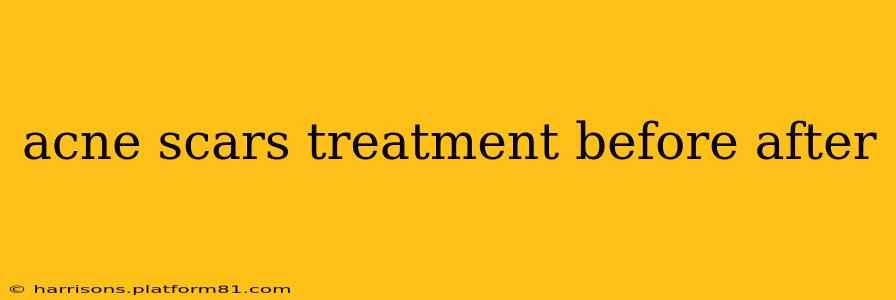Acne scars can be a frustrating and persistent reminder of past breakouts. Fortunately, numerous effective treatments are available to minimize their appearance and improve your skin's overall texture. This comprehensive guide explores various acne scar treatment options, showcasing before-and-after results and helping you understand what you can realistically expect from each.
What Causes Acne Scars?
Before diving into treatments, it's crucial to understand how acne scars form. Inflammation from acne breakouts damages the underlying skin tissue. The body's healing process attempts to repair this damage, but the result can be discolored or textured skin, leading to various types of acne scars:
- Ice pick scars: Deep, narrow pitted scars.
- Boxcar scars: Wide, U-shaped pitted scars.
- Rolling scars: Wide, uneven scars with a rolling appearance.
- Hypertrophic scars: Raised, red scars.
- Keloid scars: Overgrown, raised scars that extend beyond the original wound.
The severity and type of scarring depend on several factors, including the severity of the acne, skin type, and individual healing response.
What are the Different Acne Scar Treatment Options?
Several effective treatments are available, ranging from minimally invasive procedures to more complex surgical options. The best choice depends on the type and severity of your scars, your skin type, and your budget.
1. Topical Treatments:
- Retinoids: These vitamin A derivatives increase cell turnover, promoting collagen production and reducing the appearance of fine lines and acne scars. They're often used as a first-line treatment for mild scarring.
- Chemical Peels: These exfoliate the skin's outer layers, stimulating collagen production and improving skin texture. Different acid strengths cater to various scar types and skin sensitivities. Expect some redness and peeling after treatment.
- Topical Steroids: For hypertrophic and keloid scars, topical steroids can help reduce inflammation and flatten raised scar tissue.
2. Minimally Invasive Procedures:
- Microneedling: This involves using a device with tiny needles to create micro-injuries in the skin, stimulating collagen and elastin production. This can improve the appearance of various scar types.
- Microdermabrasion: A less invasive exfoliation technique that uses tiny crystals or a diamond tip to gently remove the top layer of skin, revealing smoother, healthier skin beneath.
- Laser Resurfacing: Lasers target damaged skin tissue, stimulating collagen production and reducing the appearance of scars. Different laser types treat different scar types and skin tones. This requires downtime for healing.
3. Surgical Procedures:
- Subcision: This technique involves inserting a needle under the scar to release the tethering that pulls down the skin, lifting and improving the appearance of depressed scars.
- Punch excision: This involves surgically removing the scar tissue and closing the wound with stitches. It's commonly used for ice pick scars.
- Skin grafts: For extensive or deep scarring, skin grafts may be necessary to replace damaged tissue.
What are the Before & After Results Like?
Before-and-after photos are readily available online for most acne scar treatments. However, results vary significantly depending on the treatment chosen, the severity of the scarring, and individual responses. While some treatments might show noticeable improvements after a single session, others may require multiple treatments for optimal results. It's essential to consult with a dermatologist to determine the most suitable treatment plan and realistic expectations based on your individual circumstances.
How Long Does it Take to See Results?
The timeline for seeing results varies widely depending on the chosen treatment and the severity of the acne scars. Some treatments, such as topical retinoids, may take several months to show noticeable improvements. Minimally invasive procedures like microneedling typically show results within a few weeks to months, while surgical procedures may require more significant healing time. Your dermatologist will provide a more accurate timeline based on your specific treatment plan.
What is the Cost of Acne Scar Treatment?
The cost of acne scar treatment varies considerably depending on the type of treatment, the number of sessions required, and the dermatologist's fees. Topical treatments are generally the most affordable, while surgical procedures are significantly more expensive. It's always advisable to obtain a detailed cost breakdown from your dermatologist before starting any treatment.
Are there any Side Effects?
Most acne scar treatments have potential side effects, ranging from mild to severe. These can include redness, swelling, bruising, infection, and scarring (in rare cases). Your dermatologist will discuss the potential risks and side effects of each treatment option before you begin. Following post-treatment care instructions diligently is crucial to minimize complications and maximize positive outcomes.
What is the Best Treatment for Acne Scars?
There's no single "best" treatment for acne scars. The optimal approach depends on the individual's unique circumstances, including the type and severity of the scarring, skin type, budget, and personal preferences. Consulting a board-certified dermatologist is crucial to receive a personalized assessment and treatment plan that addresses your specific needs and goals. They can guide you through the various options, discuss potential risks and benefits, and help you make an informed decision about the best course of action. Remember, patience and realistic expectations are key to achieving successful acne scar treatment.
